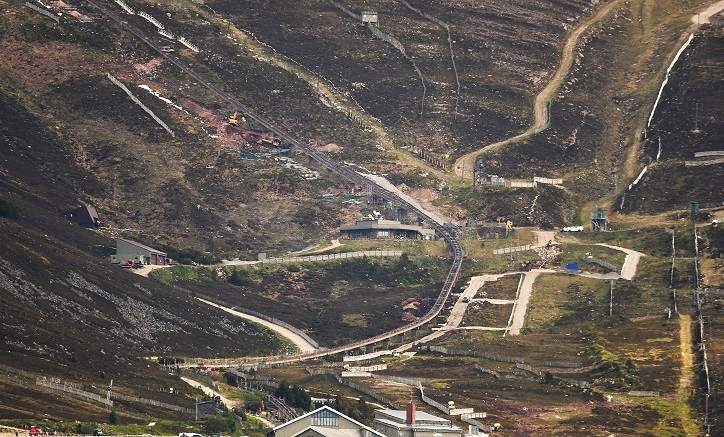
Following my post on the construction of the tube slides in the Lower Coire Cas car park (see here), this post takes a look at the repair work to the funicular. Parkswatch has previously raised a number of significant concerns about the decision to repair the funicular, including the business case and likely costs, the adequacy of the planning process and whether the repairs would work (see here for links to seven posts by Graham Garfoot). There is now a growing body of evidence to support these concerns further: the response from the new owners of Morrison’s Construction to Highland and Island’s Enterprise’s attempt to sue them for flaws in the original construction; the latest plans for the repairs submitted to the Cairngorms National Park Authority and the evidence of what is happening on the ground.
Who was responsible for the funicular design failure?
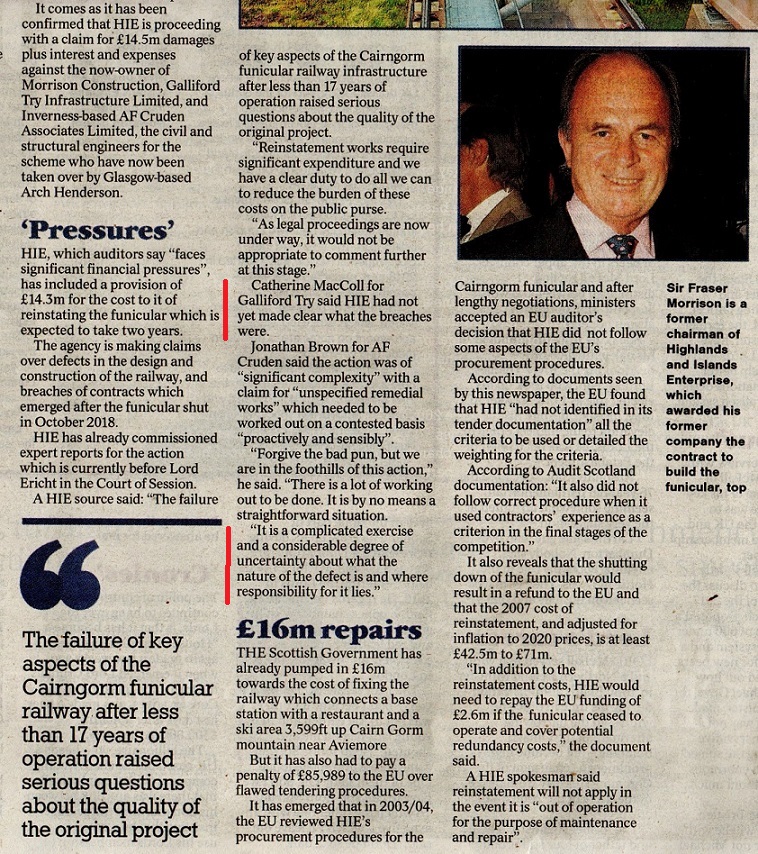
The headline of this article (see here) presented the story about HIE’s attempt to sue the now owners of Morrison’s Construction and Cruden’s for £14.5m as an “Exclusive” when this information has been in the public realm for a long time. But the information that HIE paid the EU an £85,989 penalty for flawed tendering processes appears to be new. More importantly, given the vast sums of money being spent on the funicular current repairs, Martin Williams extracted quotes (highlighted) from the new owners of A.F. Cruden and Morrison’s. Both indicate that HIE still does not know why the funicular failed.
As Parkswatch has argued for some time, without establishing what has gone wrong and given that it was HIE who decided to change the from steel to concrete support beams as part of cost-cutting measures, it is very difficult to see how any legal action could be successful. But this also means that there is a considerable degree of uncertainty about how long the repair work currently underway is likely to work. Perhaps, the reports that HIE has commissioned and now lie before Lord Ericht in the Court of Session are NEW and do reveal why the funicular failed? But if so, where does that leave the repairs granted planning permission? These were designed on the basis of engineering reports that were extremely limited in scope, for example because no ground investigations were carried out.
The Herald article also states the repair work, which started last November, “is expected to take two years”. This contradicts HIE’s news release of 2nd June (see here) which stated the funicular is “due to come back into service in winter 2021-22 following completion of strengthening works that are currently underway”. If the Herald is right, that raises significant questions about the potential costs of the works and also their alleged benefits, with another ski season potentially lost.
Changes to the repair plans
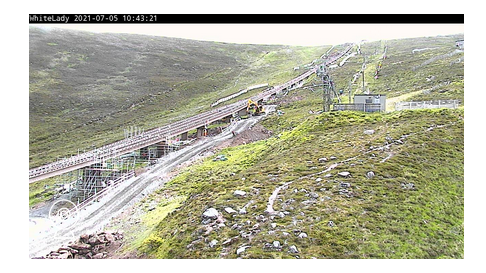
In the report to the Cairngorms National Park Authority Planning Committee last May, drawings (see here) were included of proposals to strengthen the support beams with braces and add 63 props to the 94 piers that supported the viaduct. These, it was claimed, “will involve minor earth works to allow construction”.
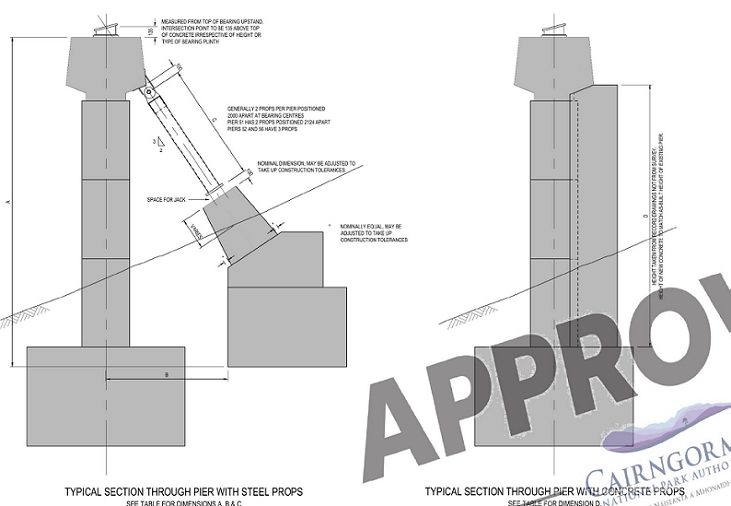
Condition 10 of the CNPA’s Planning Consent required HIE to supply details of the materials and finishes to be used in the props before work could commence. In March this year, before the repair work commenced, HIE submitted two new documents which are now on the CNPA planning portal (see here). They are quite informative, even if the finishes were not specified: instead reference was made to Clause 1708 of the Specification for Highway Works (see here) which leaves questions of colour and texture open. We know what the trapezoid blocks which will connect the steel props to the new foundations will look like, however, because they were pre-cast and stored in the car park

What the documents do show that is instead of adding props supported by new foundations to all 63 piers, the plan now is to reinforce 19 of the piers with additional concrete supports, as in the diagram on the right and, in three cases, to strength the piers with short concrete jackets.
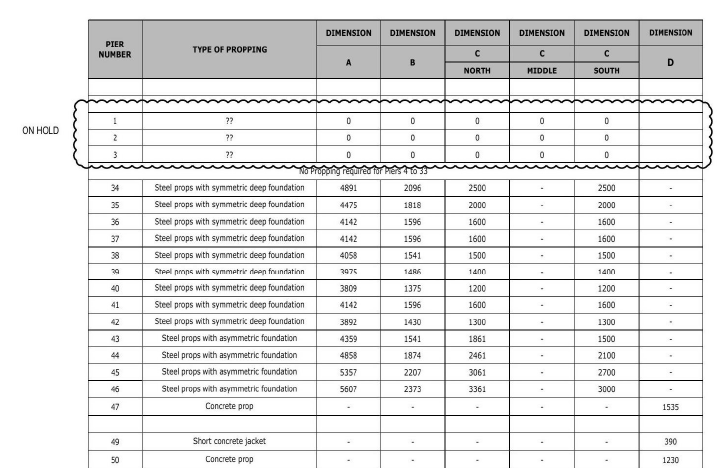
(As an aside, note how in the case of the first three piers, the props are described as being “on hold”. That hardly inspires one with confidence that HIE has got to the bottom of what has gone wrong).
The revised proposal to install 22 concrete props/jackets suggests that in these cases the problem has not been that the piers are tilting, but rather they are not strong enough to support the viaduct above. Given that the other piers appear to be tilting and need propping up due to inadequate foundations, one wonders at the wisdom of adding a lot more weight to the foundations of these 22 piers. How does HIE know that the new concrete props won’t make the foundations tilt or slide?
That there is a high risk of some of the existing foundations moving is illustrated by the recent planning documentation. The contractors have been instructed to make sure the foundations for the new steel props are no deeper than the existing foundation to prevent undermining them: 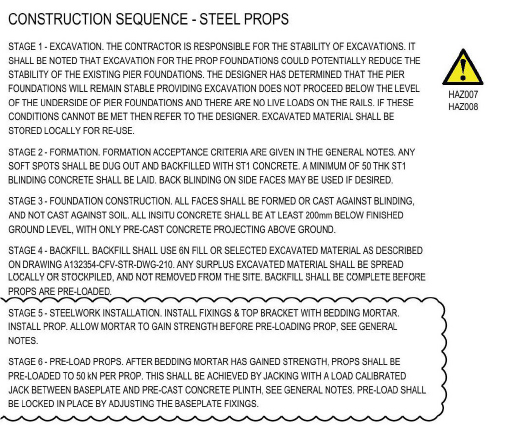 The basic problem, that the foundations of funicular piers were never secured to the bedrock but were laid on glacial deposits, has never been addressed. Those deposits are slowly moving downhill through force of gravity and the action of groundwater. There is some acknowledgement of this in the latest plans which require geotechnical tests of ground stability:
The basic problem, that the foundations of funicular piers were never secured to the bedrock but were laid on glacial deposits, has never been addressed. Those deposits are slowly moving downhill through force of gravity and the action of groundwater. There is some acknowledgement of this in the latest plans which require geotechnical tests of ground stability:
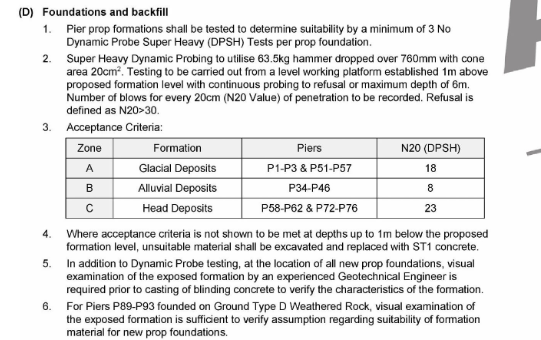 How this fits with the instructions to the building engineers to keep the bottom of the new foundations (known as the “formation level”) ABOVE the existing foundations is unclear. I am not an engineer but 6m deep probes and instructions to excavate out any unsuitable material up to 1m below the formation level appear inconsistent with that. Nothing is said either about the risk of a hydraulic hammer / breaker to test the ground conditions causing vibration damage to the existing structure and the ground below helping to destabilise the existing piers still further.
How this fits with the instructions to the building engineers to keep the bottom of the new foundations (known as the “formation level”) ABOVE the existing foundations is unclear. I am not an engineer but 6m deep probes and instructions to excavate out any unsuitable material up to 1m below the formation level appear inconsistent with that. Nothing is said either about the risk of a hydraulic hammer / breaker to test the ground conditions causing vibration damage to the existing structure and the ground below helping to destabilise the existing piers still further.
HIE’s hope appears to be that if they pay for enough concrete that will stabilise the funicular structure. With proper ground investigations it appears just as likely that all the extra weight may just increase the forces that are making the funicular slide slowly downhill! There is no explanation of how the new foundations which do sit on bedrock (piers 89 – 93) will be secured to it.
What’s happening on the ground
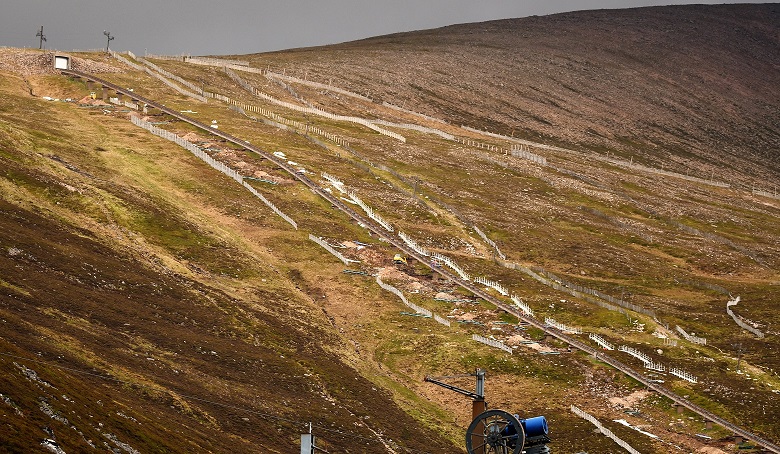
The section of the funicular where the repairs are having least impact at present is above the mid-station on the steeper ground. Above pier 62 materials are being flown in by helicopter and there is no sign of temporary construction tracks (though these were mentioned in the planning documents). A pedestrian walkway has been installed to prevent ground damage. The CNPA will be pleased.
However, the piles of excavated material will have a significant impact on ground vegetation. The latest plans state that for the foundations supporting the steel props “any surplus excavated material may be spread locally or stockpiled”. Where the stockpile will be taken and how the ground beneath it will be restored is still not clear. What should be obvious though is that any material “spread locally” will be simply be washed downhill.
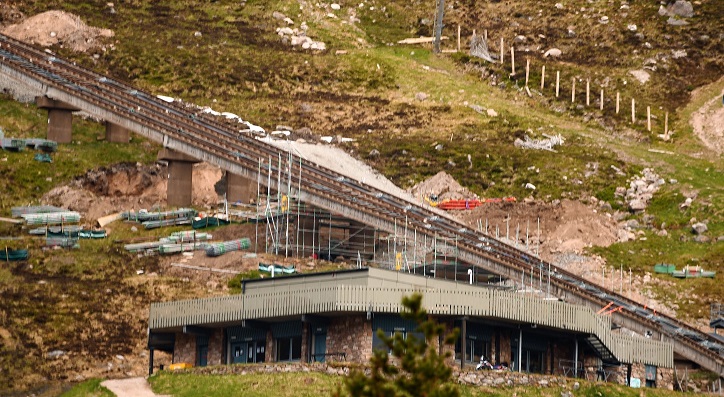
The area around the double track passing place and loading station appears far worse: huge holes, a large excavated “temporary” access track (on the far side) and piles of excavated material.
On the lower half of the funicular, where less repair work is planned, the main impact so far is the construction tracks:
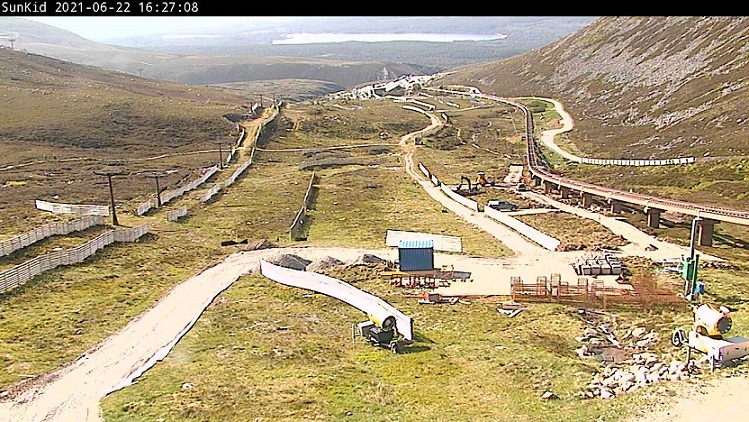
The track on the left was constructed unlawfully as part of the installation of the SunKid tow (see here) but then granted retrospective planning permission by the CNPA. It has now been “temporarily” upgraded and a further new temporary track created parallel to the funicular to provide access for the repair work. A geotextile, visible on the left of the screenshot, has been placed below the new surface. This appears to follow a recommendation from SEPA that “all temporary tracks where
peat would otherwise be excavated comprise of geotextile or plastic track matting unless there is a significant technical reason why this is not feasible.”
While the ground by the funicular is very peaty, any peat under the sunkid track was destroyed during its construction (see link above for photos). All the geotextile matting will do therefore is kill the vegetation below. Where the track needed to be widened temporarily It would have been far less damaging to have excavated and saved the surface vegetation and then replaced this. The photos provide no evidence that such protection and restoration techiques are happening at Cairn Gorm, whether on the temporary access tracks or around the pits that have been excavated for the new piers. My guess is that is far too expensive and instead HIE will re-seed the damaged areas in due course.
What will happen next?
Parkswatch intends to monitor the repair work quite closely over the coming months, not least because the potential for ecological catastrophe at Cairn Gorm now appears very high. During the thunderstorms on Sunday the rain guages at Cairn Gorm show there were only a few mm of precipitation. Imagine, however, that the 5cm of water which fell at Grantown had fallen on the construction site……………..in granting planning permission for the repair of the funicular the CNPA has allowed HIE to embark on a massive gamble the true costs of which are still to be seen.
The public road to the Cairn Gorm ski slopes has been breached three times by flood water pouring off the mountain during the 60 year history of these developments. Detailed explanations of the dangers of this situation were given at the Lurchers Gully Public Inquiry in 1981, with an emphasis on the need to minimise the amount of bare ground on the mountain resulting from roads, pistes and any construction work. The photos today suggest that many of these lessons still have not yet been learnt and these are probably now the most fragile mountain slopes in the UK. Anyone thinking of driving, camping or spending time on the lower slopes of this mountain during a thunderstorm or heavy rainstorm should think again.
I seem to remember that when the funciular was conceived, the general engineering advice was that it should run underground. In awarding the construction contract to build it above ground and then deciding to use concrete instead of steel, HIE must accept some responsibility fro the subsequent failures in the structure.
In the unlikely (in my opinion) event that HIE is successful in its legal actions, the award should be tempered with a hefty dollop of contributory negligence from HIE
If this wasn’t so serious it could be a joke! The original planning application documents, which I have gone over again, showed only TWO blocks of concrete for the props, NOT THE FOUR that are now shown and no mention whatsoever of concrete props on the original foundations! ” The foundations will be largely underground while props are slim”!!! Why has that been changed? Has something been discovered that meant the original propping arrangement could not be used? Is that why Super Heavy Dynamic Probing is now being used and at what extra cost? What are the physical dimensions of the concrete props alongside the original piers and how much weight is involved? How will these concrete props affect the snow holding of the viaduct with increased time and labour to clear the tracks? “(D) Foundations and Backfill. 4. Where acceptance criteria is not shown to be met at depths upto 1m below the proposed formation level, unsuitable material shall be excavated and replaced with ST1 concrete.” What this statement says is that no one knows (1)how deep the prop foundations will be, (2) how much extra material will need to be removed and subsequently disposed of, (3) how much extra concrete will be needed and again (4)what will all this cost! All of this proves that the Funicular should never have been built in the first place, the CNPA have no control over what is going on and HIE’s lack of a full investigation into the Funicular failure is now going to cost a lot more than the original budget, the open-ended cheque book that was first mentioned in the Audit Scotland report of 2009. Work should be halted now until an uptodate appraisal and costing is carried out by independent surveyors and/or a costing of a chair/ gondola hybrid, with the removal of the Funicular, considered by HIE or Scottish Government as should have happened when the Financial Business Case was produced.
Way back in the 1970’s myself and my cousin had a lazy walking day around Corrie Cas. There was still a big snow bed on the head wall so we went for a play around. The snow was melting fast. At one point I remember making a big jump off the snow down onto the top of a boulder about the size of a small car. On impact, the boulder moved about a foot downslope.
We left the area fairly smartly.
I have been again reading my posts on Parkswatch “Will the repair of the Cairn Gorm Funicular work”. HIE at that time had not carried out a comprehensive survey as to ALL the causes which caused the Funicular to be removed from service and yet now it would appear, reference the Super Heavy Dynamic Probing, that at least something is happening along those lines. But why now? The answer to that, in my opinion, is that if a full examination had been requisitioned these faults that are being uncovered now would have substantially increased the estimated costs of the repairs to the point where the Scottish Government and in particular Finance Minister Kate Forbes may have denied HIE’s funding requests! This raises the question as to whether or not HIE deliberately avoided a full survey and report knowing that the end result could have been no funding for the repairs? It would also have made the case for a chair /gondola hybrid, an option which was not even considered by HIE, and the removal of the Funicular over a period of time a much more economically sound proposition. Everything that is going on here proves that Sir Edward Mountain(MSP) and others opinions that a judge lead enquiry is necessary should be actioned as soon as possible.
Looks like a failed industrial site and not the once proud mountain of our youth, HIE directors and past politicians need investigated for failure to act in the public’s interests, taxpayers money doesn’t come from the fairies and the damage done and being done to the mountain is unrepairable.
yes: what they’ve done could have been done anywhere: e.g. brownfield site. instead, they’ve trashed what was a uniquely amazing mountain. so sad. and deplorable if the mix of venality and incompetence is allowed to continue.